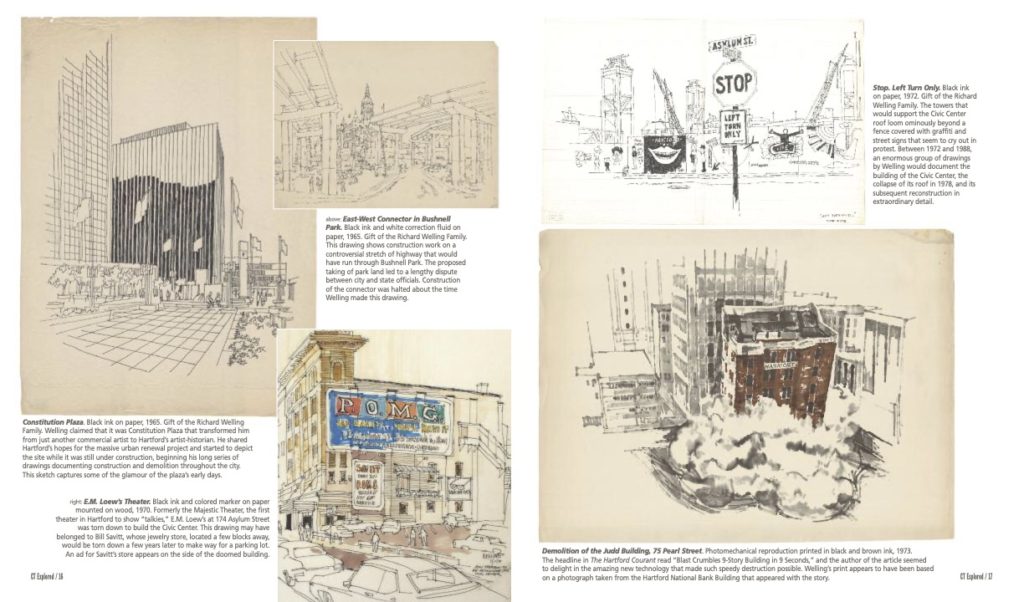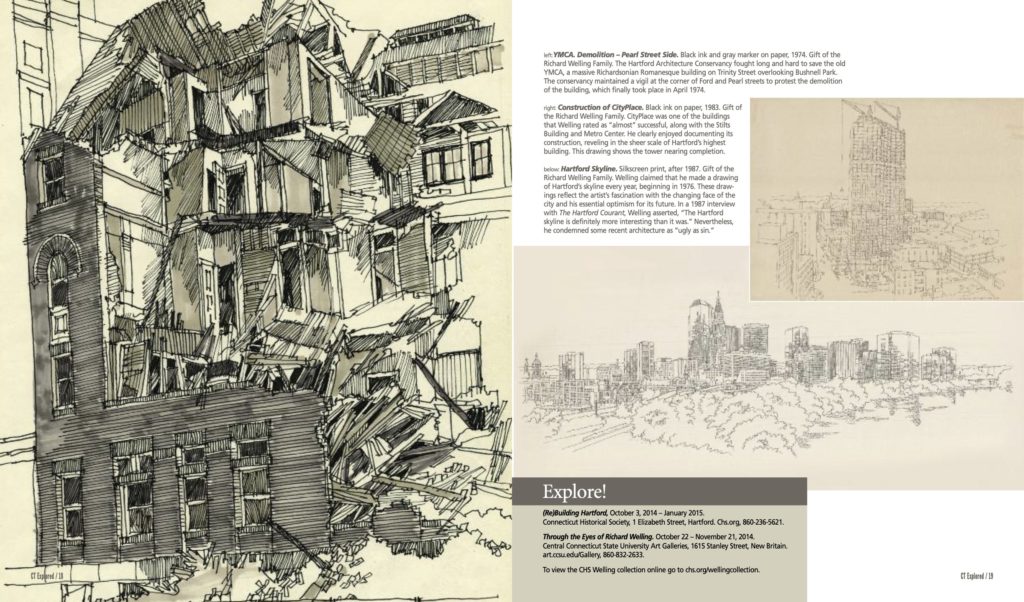
Cubist Reflection. Black and colored ink on paper, 1974. Connecticut Historical Society, gift of the Richard Welling Family. Juxtapositions between the old and new recur throughout Welling’s work. In this drawing, the Travelers Tower is reflected in One Financial Plaza, the artist taking full advantage of the reflective quality of the skyscraper’s glass skin.
By Nancy Finlay
(c) Connecticut Explored Inc. Fall 2014
Subscribe/Buy the Issue!
Canaletto painted Venice. The French Impressionists celebrated the monuments and boulevards of Second Empire Paris. Numerous artists and printmakers have portrayed the changing face of New York City. But no artist documented Connecticut’s capital city in such detail as Richard Welling did in the mid-20th century.
Welling grew up in West Hartford, graduating from Hall High School in 1944, just in time to join the army and serve in World War II. Upon his discharge in 1946, he went to New York City to attend Parsons School of Design. When he returned to Hartford in 1949 to work as a commercial artist, the city that he had known as a boy was still largely intact. Main Street still featured big marble, brick, and brownstone Victorian buildings erected during the 19th century, when Hartford had been a major center of insurance, banking, publishing, and industry. The streets still were lined with shops, and sidewalks bustled with activity.
During the 1960s, these buildings started to come down to make way for a new city of soaring skyscrapers built of concrete, steel, and glass. Usually using the spare medium of pen-and-ink drawing for which he became so well known, Welling was on the spot to record the destruction of beloved icons such as the old Hartford Public High School and the old YMCA, along with the construction of such new landmarks as Constitution Plaza and the Hartford Civic Center. As whole blocks and neighborhoods fell to the wrecking ball, the artist was forced to move again and again, from one studio to another, experiencing first-hand the impact of urban renewal. His first studio was in the old Palace Theater building on Main Street, which was torn down to make way for Bushnell Tower. He then moved to 29 Pearl Street, 721 Main Street, and 44 State Street, the Honiss Restaurant building. By the mid-1980s, all were gone, demolished to make way for Bushnell Tower, the Hartford Civic Center, One Financial Plaza, and State House Square. Some of Welling’s most powerful drawings from this period incorporate signs and graffiti that suggest his sense of loss and outrage.
Welling was frequently cited in The Hartford Courant as Hartford’s artist-historian, but he was never simply a dispassionate observer; he was outspoken in his opinions, in his likes and dislikes. Although he admired good modern architecture, he hated to see a good building torn down in order to erect a mediocre building in its place. He abhorred One Financial Plaza (the Gold Building) and the massive 1972 addition to the Aetna Life & Casualty Company on Flower Street, but he liked Constitution Plaza, CityPlace, and One Corporate Center (the Stilts Building) And he loved the Old State House, the Connecticut State Capitol, and Union Station. His last apartment and studio were located in Union Place, one of Hartford’s first successful rehabs of a 19th-century commercial building.
After the artist’s death in 2009, the contents of this studio were given to the Connecticut Historical Society by Welling’s family. Consisting of more than 5,000 individual items, the collection includes drawings, prints, and photographs by the artist, manuscripts and diaries, artifacts such as his signature hard hat, and his drawing implements. Selections from the collection will be on view at the Connecticut Historical Society from October 3, 2014 through January 2015 in (Re)Building Hartford, an exhibition about the impact of the built environment on people’s lives. Related satellite exhibitions at locations throughout the city will explore aspects of the theme in depth. Additional drawings by Welling will be featured in a second exhibition at Central Connecticut State University that will focus on Welling’s achievement as an artist.
All works are in the collection of the Connecticut Historical Society.
 Constitution Plaza. Black ink on paper, 1965. Gift of the Richard Welling Family. Welling claimed that it was Constitution Plaza that transformed him from just another commercial artist to Hartford’s artist-historian. He shared Hartford’s hopes for the massive urban renewal project and started to depict the site while it was still under construction, beginning his long series of drawings documenting construction and demolition throughout the city. This sketch captures some of the glamour of the plaza’s early days.
Constitution Plaza. Black ink on paper, 1965. Gift of the Richard Welling Family. Welling claimed that it was Constitution Plaza that transformed him from just another commercial artist to Hartford’s artist-historian. He shared Hartford’s hopes for the massive urban renewal project and started to depict the site while it was still under construction, beginning his long series of drawings documenting construction and demolition throughout the city. This sketch captures some of the glamour of the plaza’s early days.
East-West Connector in Bushnell Park. Black ink and white correction fluid on paper, 1965. Gift of the Richard Welling Family. This drawing shows construction work on a controversial stretch of highway that would have run through Bushnell Park. The taking of park land led to a lengthy dispute between city and state officials. Construction of the connector was halted about the time Welling made this drawing.
E.M. Loew’s Theater. Black ink and colored marker on paper mounted on wood, 1970. Formerly the Majestic Theater, the first theater in Hartford to show “talkies,” E.M. Loew’s at 174 Asylum Street was torn down to build the Civic Center. This drawing may have belonged to Bill Savitt, whose jewelry store, located a few blocks away, would be torn down a few years later to make way for a parking lot. An ad for Savitt’s store appears on the side of the doomed building.
Stop. Left Turn Only. Black ink on paper, 1972. Gift of the Richard Welling Family. The towers that would support the Civic Center roof loom ominously beyond a fence covered with graffiti and street signs that seem to cry out in protest. Between 1972 and 1988, an enormous group of drawings by Welling would document the building of the Civic Center, the collapse of its roof in [year], and its subsequent reconstruction in extraordinary detail.
Demolition of the Judd Building, 75 Pearl Street. Photomechanical reproduction printed in black and brown ink, 1973. The headline in The Hartford Courant read “Blast Crumbles 9-Story Building in 9 Seconds,” and the author of the article seemed to delight in the amazing new technology that made such speedy destruction possible. Welling’s print appears to have been based on a photograph taken from the Hartford National Bank Building which appeared with the story.
 YMCA Demolition – Pearl Street Side. Black ink and gray marker on paper, 1974. Gift of the Richard Welling Family. The Hartford Architecture Conservancy fought long and hard to save the old YMCA, a massive Richardsonian Romanesque building on Trinity Street overlooking Bushnell Park. The conservancy maintained a vigil at the corner of Ford and Pearl streets to protest the demolition of the building, which finally took place in April 1974.
YMCA Demolition – Pearl Street Side. Black ink and gray marker on paper, 1974. Gift of the Richard Welling Family. The Hartford Architecture Conservancy fought long and hard to save the old YMCA, a massive Richardsonian Romanesque building on Trinity Street overlooking Bushnell Park. The conservancy maintained a vigil at the corner of Ford and Pearl streets to protest the demolition of the building, which finally took place in April 1974.
Construction of CityPlace. Black ink on paper, 1983. Gift of the Richard Welling Family. CityPlace was one of the buildings that Welling rated as “almost” successful, along with the Stilts Building and Metro Center. He clearly enjoyed documenting its construction, reveling in the sheer scale of Hartford’s highest building. This drawing shows the tower nearing completion.
Hartford Skyline. Silkscreen print, after 1987. Gift of the Richard Welling Family. Welling claimed that he made a drawing of Hartford’s skyline every year, beginning in 1976. These drawings reflect the artist’s fascination with the changing face of the city and his essential optimism for its future. In a 1987 interview with The Hartford Courant, Welling asserted, “The Hartford skyline is definitely more interesting than it was.” Nevertheless, he condemned some recent architecture as “ugly as sin.”
Nancy Finlay is curator of graphics at Connecticut Historical Society. She last wrote for Connecticut Explored about CHS’s 1784 Abel Buell map in “The Two-Million-Dollar-Map,” Spring 2012.
Explore!
(Re)Building Hartford, October 3, 2014 – January 2015. Connecticut Historical Society, 1 Elizabeth Street, Hartford. Chs.org, 860-236-5621.
Through the Eyes of Richard Welling. October 22 – November 21, 2014. Central Connecticut State University Art Galleries, 1615 Stanley Street, New Britain. art.ccsu.edu/Gallery, 860-832-2633.
To view the CHS Welling collection online go to chs.org/wellingcollection.
Read all of our stories about Connecticut’s art history on our TOPICS page
Read all of our stories about Notable Connecticans on our TOPICS page
